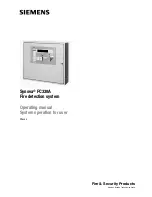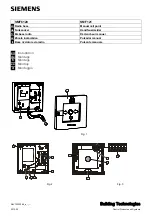
11
[14] 3rd System Option Code
Use the same method of programming as section [12].
ZONE
LIGHT
[1]
ON = Access code required for bypass
• OFF = Access code not required for bypass
[2]
ON = Enable [
*
][4] downloading call feature
• OFF = Disable [
*
][4] call feature
1
1
1
1
1
[3]
ON = Periodic downloading
2
2
2
2
2
• OFF = Periodic test transmission
[4]
ON = [
*
][4] requires a access code
• OFF = [
*
][4] does not require access code
[5]
• ON = [P]anic key has keypad-audible feedback
OFF = [P]anic key without keypad-audible feedback
[6]
ON = Partial closings identified
3
3
3
3
3
• OFF = Partial closings not identified
• Factory default settings
1
When option [2] is enabled, the user or on-site installer can
initiate a call to the downloading computer by pressing [
*
][4].
2
The panel can be enabled to periodically call the downloading
computer. The cycle time (in days) for the call is set in section
[19]. The automatic call to the downloading computer can be
used to update the panel program and / or to upload status
information from the panel.
3
If partial closings are enabled as identified, then alarm codes for
the bypassed zones will be transmitted.
[15] Communication Variables
Once this section is entered, two 2-digit numbers are expected. Do
not press [#] while entering data. The first 2-digit number defines
the number of attempts (alarm and restoral pairs) per zone that the
communicator will make before it shuts down for that zone (swinger
shutdown). The number of attempts is for the period as defined in
the 1st System Option Code Section, zone light 2. The number of
attempts may be programmed from ‘00’ to ‘99’, where ‘00’ means
the communicator will never shut down. The fire zone cannot be
shut down - it always transmits.
The second 2-digit number defines the delay before transmission,
for zones defined as burglary zones only. 24 hour loops or the fire
loop will not be delayed. The time may be programmed from ‘00’ to
‘99’ seconds, where ‘00’ means no delay.
[16] Zone Bypass Mask
Use the same method of programming as used in section [12]. If
the zone light is ON, the zone can be bypassed; if OFF, the zone
cannot be bypassed using [
*
][1]. The fire zone cannot be bypassed.
[17]
System Times
There are 6 system times which can be programmed in this section,
and each entry requires a 3-digit number. Do not press [#] during
data entry.
[1] Entry delay time
(001 to 255 seconds) This value determines
the standard Entry Delay time. The factory default entry time is
30 seconds. See Section [11] for zone definitions.
[2] Exit delay time
(001 to 255 seconds) This value determines the
standard Exit Delay time. The factory default exit time is 120
seconds. For zone definitions, see Section [11].
[3] Bell cut-off time
(001 to 255 minutes) This value determines
the time the bell / siren will sound before automatically turning
off. The factory default bell cut-off time is 4 minutes.
[4] AC fail transmission delay
(001 to 255 minutes) This value
determines the length of time before the communicator will
transmit an AC failure report. The factory default time is 30
minutes.
[5] “Slow” zone response time
(001 to 255 × 10 ms) This value
Section [11], Digit #2 Summary:
[0] = Standard delay loop
[1] = Instant loop
[2] = Interior Loop
[3] = Interior... home / away loop
[4] = 24 hour... bell loop
[5] = 24 hour... bell / buzzer loop
[6] = 24 hour... buzzer loop
[7] = Auxiliary delay loop
[8] = Fire Loop
[12]
1st System Option Code
The 1st System Option Code is set using the zone lights as shown
in the table below. Once section [12] is entered, the 6 zone lights
will indicate the status of each option. Press a number key
corresponding to the zone light number to turn the option ON and
OFF. Pressing [0] will turn all the zone lights OFF and the options will
be set as shown against “Light Off”.
ZONE
LIGHT
[1]
ON = Communicator disabled
• OFF = Communicator Enabled
[2]
ON = Transmission per 24 hour period
• OFF = Transmission per armed period
[3]
• ON = Alarm display while armed
OFF = No alarm display while armed
[4]
• ON = DTMF dialling
*
OFF = Pulse dialling
[5]
ON = N.C. loops (except fire loops)
• OFF = End-of-line resistor loops
[6]
• ON = Keypad [P]anic audible
OFF = Keypad [P]anic silent
• Factory default settings
*
DTMF dialling will default to pulse dialling after 2
unsuccessful DTMF dialling attempts.
[13]
2nd System Option Code
Use the same method of programming as section [12].
ZONE
LIGHT
[1]
• ON = Call 1st phone number only
OFF = Call 1st phone number with back-up to
2nd phone number
[2]
ON = Master Code not user changeable
• OFF = Master Code user changeable
[3]
ON = Bell squawk enabled*****
• OFF = Bell squawk disabled
[4]
ON = PC16OUT module enabled
• OFF = PC16OUT module disabled
[5]
ON = 6th code is “maid’s code”
(one-time use)
• OFF = 6th code is normal access code
[6]
ON = 1400 Hz handshake for Radionics
formats # 3, 4, B and C
• OFF = 2300 Hz handshake for Radionics
formats # 3, 4, B and C
• Factory default settings
*
With bell squawk enabled, the bell / siren will sound one
short burst on arming and two short bursts on disarming.
NOTE:
When the panel is set for Auto-Arming, the bell / siren will
sound 1 short burst every 10 seconds for one minute before the
panel Auto-Arms unless the ‘Bell During Auto-Arm’ is disabled
(section [32], light 2).
Summary of Contents for PC1550
Page 23: ......

































